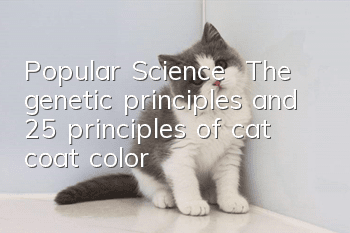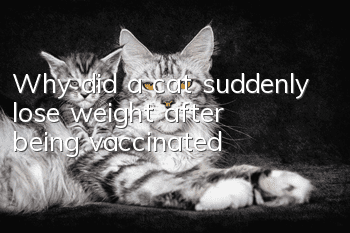Popular Science | The genetic principles and 25 principles of cat coat color

When talking about the genetic principles of cat coat color, when talking about coat color group-refers to (blue, black, cream, red, etc.) and pattern group-refers to (tabby, fireworks, shade, etc.), if both When used, the following general rules will combine coat color/pattern.
1. Male kittens will receive two coat color genes from the female cat, and the children of the male cat will receive the coat color of the female cat (if it is a parti-colored female cat, one of the coat colors) or lighten the coat color of the male cat
2. The young female cat receives one coat color gene from each parent cat, and the offspring of the female cat will mix or dilute the coat color of the parent cat
3. To get a cream or red (coat color/color) kitten female cat, the male cat must be cream or red (coat color/color) plus the female cat must also be red or cream color
4. Only the coat colors/colors of a kitten’s direct parents can be displayed on the kitten. Not all the previously grouped coat colors/colors that appear on the pedigree will be directly applied to the kitten. One notable exception It is the terminal color gene, which can be displayed by carrying it through several offspring-
5. The colors of kittens can come from the parent cat or the female cat
6. Some main characteristics (main coat color and pattern color, such as: fireworks, shadow, white, tabby, two-color, etc.) will not skip the previous generations. These characteristics will not directly affect the next generation without showing up.
7. If a cat shows a dominant coat color (black, red, tortoise shell, etc.), its parent cat or female cat must show a dominant coat color
8. Two parents with recessive coat colors (cream, blue, etc.) will not breed kittens with dominant coat colors (black, red, etc.).
9.Two parents with terminal colors will not produce kittens with no terminal colors.
10. To get a terminal color kitten, both his parents must carry the terminal color gene (even if they do not show terminal color).
11. Mating a cat with terminal color and a cat without terminal color ancestor genes will produce kittens without terminal color.
12. A (non-silver) tabby cat, one of her parents must be shaded or tabby. A silver tabby cat, one of its parents must be silver tabby, shaded, or fireworks.
13. All red cats will definitely have tabby patterns. To be considered a "red tabby", you must see whether its parent cat shows tabby patterns or has a shadow color. A red tabby cat, if He is not a true tabby cat. Unless you mate with a cat with dominant tabby or shadow colors, you will not be able to produce a true red tabby kitten.
14. One has a white bottom layerFor cats with fur (Firework or Shade), one of his parents must also have a white undercoat.
15. A shaded cat must have one of its parents that is shaded.
16. A shaded cat can produce fireworks colored offspring, but a non-shaded (fireworks) cat cannot produce shaded offspring unless it mates with a shaded cat.
17. Bi-color cats must have one parent who is a bi-color cat.
18. Most of the colorful cats (blue cream, tortoiseshell, tricolor) are female cats, but male cats still occasionally appear (and not all of them are sterile).
19. A white cat, one of its parents is a white cat.
20. If a white cat mates with a white cat (it can be seen that it is white) or with a cat marked white (it cannot be seen that it is white), it can produce white or the marked coat color/color. .The marked coat color/pattern color cat must be dominant, but has a white coat bloodline. His offspring can still produce offspring of the coat color/pattern color as expected during planned breeding.
21. Genetically speaking, single-color white cats can be used to predict the coat color/color of kittens, and such kittens will be marked with the coat color/color.
22.2 Long-haired parents will not produce short-haired offspring.
23. Two parents with classic tabby patterns will not produce kittens with herringbone, spots, or pointy tabby patterns. A cat with pointy tabby patterns must have one parent who also has pointy tabby markings. A herringbone pattern kitten One of the parents of a tabby or spotted tabby must be a herringbone tabby or a spotted tabby.
24. The diluted color gene must appear in the pedigree of both parents in order to produce diluted coat color.
25. The chocolate and lilac color genes must appear in the bloodlines of both parents at the same time to produce chocolate or lilac colored cats.
- How to tell if a cat has a fever without a thermometer
- Causes and treatments of pet cat ear scabies
- Do cats need additional nutritional supplements besides eating cat food? The nutrients cats need every day!
- How to make a cat remember its name and learn to shake hands
- At what age can a cat be dewormed? Teach you step by step how to raise a cat and deworm it!
- Why cats don’t like to be hugged
- What should I do if my cat is frightened and stressed by the hair dryer while taking a bath?
- How to tell if a cat is throwing up hairballs or vomiting
- How to trim a cat's nails
- Your cat’s vision seems to have declined? Be careful when petting your cat!



